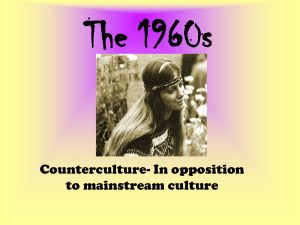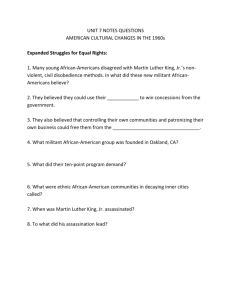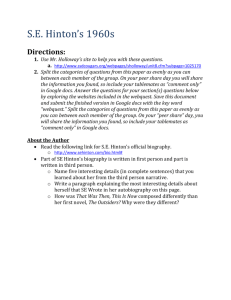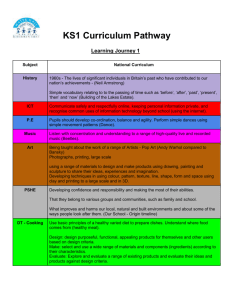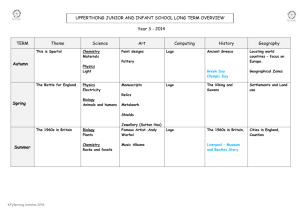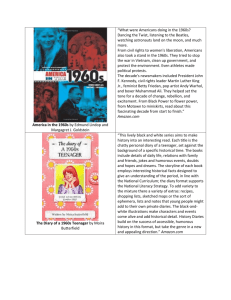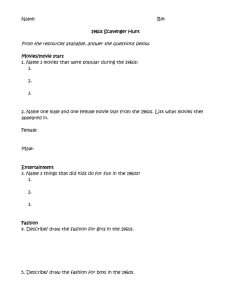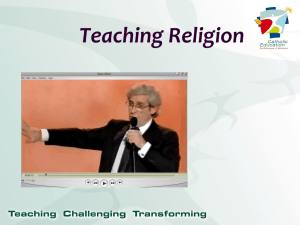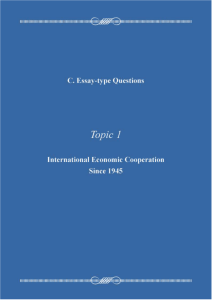1960s activity - OISEHistoryPosWorldWarII
advertisement
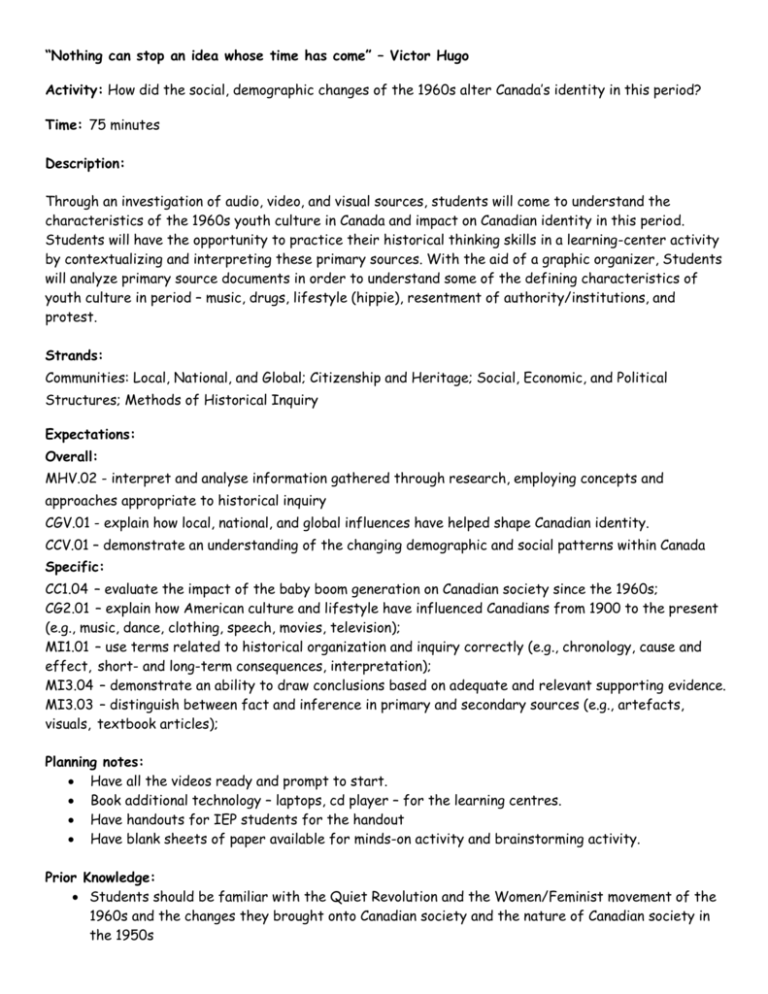
“Nothing can stop an idea whose time has come” – Victor Hugo Activity: How did the social, demographic changes of the 1960s alter Canada’s identity in this period? Time: 75 minutes Description: Through an investigation of audio, video, and visual sources, students will come to understand the characteristics of the 1960s youth culture in Canada and impact on Canadian identity in this period. Students will have the opportunity to practice their historical thinking skills in a learning-center activity by contextualizing and interpreting these primary sources. With the aid of a graphic organizer, Students will analyze primary source documents in order to understand some of the defining characteristics of youth culture in period – music, drugs, lifestyle (hippie), resentment of authority/institutions, and protest. Strands: Communities: Local, National, and Global; Citizenship and Heritage; Social, Economic, and Political Structures; Methods of Historical Inquiry Expectations: Overall: MHV.02 - interpret and analyse information gathered through research, employing concepts and approaches appropriate to historical inquiry CGV.01 - explain how local, national, and global influences have helped shape Canadian identity. CCV.01 – demonstrate an understanding of the changing demographic and social patterns within Canada Specific: CC1.04 – evaluate the impact of the baby boom generation on Canadian society since the 1960s; CG2.01 – explain how American culture and lifestyle have influenced Canadians from 1900 to the present (e.g., music, dance, clothing, speech, movies, television); MI1.01 – use terms related to historical organization and inquiry correctly (e.g., chronology, cause and effect, short- and long-term consequences, interpretation); MI3.04 – demonstrate an ability to draw conclusions based on adequate and relevant supporting evidence. MI3.03 – distinguish between fact and inference in primary and secondary sources (e.g., artefacts, visuals, textbook articles); Planning notes: Have all the videos ready and prompt to start. Book additional technology – laptops, cd player – for the learning centres. Have handouts for IEP students for the handout Have blank sheets of paper available for minds-on activity and brainstorming activity. Prior Knowledge: Students should be familiar with the Quiet Revolution and the Women/Feminist movement of the 1960s and the changes they brought onto Canadian society and the nature of Canadian society in the 1950s Students should have knowledge about how to analyze, contextualize, interpret primary source documents Students have knowledge of interpreting and analyzing political cartoons. Teaching/ Learning Strategies: 1. Working in groups of three, students will write down elements creating a mind map about characteristics of their youth-culture. Artistic students will have the opportunity to create a mind-map of their design. After the students have finished, the teacher would create a large mind-map on the board and lead a class discussion about the defining characteristics of a youth culture. The discussion will focus on such characteristics like music, art, hairstyle, clothes, lifestyle, resentment of authority, and individuals – like Justin Bierber. 2. In a think-pair-share exercise, students will with list everything they know about the 1960s. Students will probably mention American examples – Martin Luther King, JFK, Vietnam War, LSD, Beatles, Hippies, Woodstock, etc. 3. The teacher leads the class in a discussion about how the American experience in the 1960s was different than the Canadian experience. For instance, Canada was not involved in Vietnam or had a prominent Civil rights movement. Albeit Canada underwent a series of social changes in this period that transformed the nation as well – youth culture being one of these transformation. Students should be familiar with the Quiet Revolution and the Women/Feminist movement of the 1960s and the changes they brought onto Canadian society and the nature of Canadian society in the 1950s. Students will read related text book information, along with a PowerPoint presentation about the demographical changes and key words about the 1960s in order to discover some key terms and facts about the period. (see resources for demographics and Destinies: Canadian History since Confederation) 4. Five learning centres are set-up in the classroom with a variety of audio, video, and other materials about the 1960s. A) Audio: Magic-carpet-ride’ by Steppenwolf. B) Political cartoon about 1960s youth culture C) Video: Canadian Hippie Commune D) Audio: ‘Masters of War’ by Bob Dylan E) Video: Yorkville Beatniks and Hippies being interviewed F) Poster: 1960s fashion (See appendix 7.1 for learning centre material) Students will be placed into six groups and are expected to go around to each station for eight minutes and fill-out-the information on their graphic organizers about each of these sources. (See Appendices 7.2) 5. Once all the groups have visited each station, students working individually and using their graphic organizers have to reflect on what they have learned through answering the questions on appendix. What do these sources tell us about the changes in Canada in the 1960s? How did the youth culture transform Canada in this period? What evidence do you have to support this argument? (See Appendix 7.3) Assessment Techniques: Formative assessment by the teacher of student’s graphic organizer handout. Informal assessment through teacher observation during the learning centre exercise. Teacher asks probing questions during the activities to check for comprehension of historical skills and ability Accommodations: Working in pairs allows for stronger students to help, and weaker students seek help Students who have an IEP will get a handout copy of the PowerPoint notes. ELL students will have a handout of the song lyrics for the music portion of the learning center activity. Students with writing difficulties may benefit from teacher assistance in organizing information and completing the organizer. Resources: Demographics of 1960s: http://www.statcan.gc.ca/kits-trousses/pdf/social/edu04_0021a-eng.pdf Two videos from: http://archives.cbc.ca/society/youth/topics/580/ Bob Dylan’s Masters of War Steppenwolf’s Magic Carpet Ride Francis, R. Douglas, Richard Jones, and Donald B. Smith. Destinies: Canadian History since Confederation. Toronto: Harcourt, 2000. Appendices Appendix 7.1 a) MAGIC CARPET RIDE – by Steppenwolf I like to dream…… yes yes right between the sound machine, on a cloud of sight I drift in the night, any place it goes is right goes far, flies near, to the stars a-way from here…… Well you don't know what we could find, why don't you come with me little girl, on a magic carpet ride? Well you don't know what we could see, why don't you tell your dreams to me, fantasy will set you free close your eyes girl, look inside girl, let the sound take you away! Last night I held Aladdin's lamp, so I wished that I could stay, before the thing could answer me well someone took, took the lamp away! I looked, around, a lousy can was all I found! B) Poster Images: C) Hippie Commune Video: http://archives.cbc.ca/society/youth/topics/580/ D) Master of War by Bob Dylan Come you masters of war, you that build all the guns You that build the death place, you that build all the guns You that hide behind walls, you that hide behind desks I just want you to know, I can see through your masks You that never done nothing, but to build and destroy You play with my world, like it's your little toy You put a gun in my hand, then you hide from my eyes And you turn and run farther as the fast bullets fly Like judas of old, you lie and deceive A world war can be won, and you want me to believe But I see through your eyes, and I see through your brain Like I see through the water that runs down my drain You that fasten all the triggers, for the others to fire Then you sit back and watch, while the death count gets higher You hide in your mansion, while young people's blood Flows out of their bodies and is buried in the mud You've thrown the worst fear, that could ever be hurled The fear to bring children, into this world For threatenin' my baby, unborn and unnamed You ain't worth the blood that runs in your veins How much do I know, to talk out of turn? You might say that I'm young, you might say I'm unlearned But there's one thing I know, though I'm younger than you Even Jesus would never forgive what you do Let me ask you one question, is your money that good? Will it buy you forgiveness? do you think that it could? Oh, I think you will find, when your death takes its toll All the money you made will never buy back your soul And I hope that you die, and your death will come soon I'll follow your casket, in the pale afternoon And I'll watch as your lowered, into your deathbed And I'll stand on your grave till I'm sure that your dead E) Video: Yorkville Beatniks and Hippies: http://archives.cbc.ca/society/youth/topics/580/ F) Poster of 1960s fashion: Appendices 7.2: (Answers in Italics) Stations What does this source tell us about 1960s youth? Does it Describe a behaviour, belief, movement, etc What it tell you about the opinions/actions of the elite, old people, or young people’s perception of them? What historical questions can you answer using this source? What are the benefits of using this kind of source? Magic Carpet Ride Rise of drug culture. Psychedelic and rock n’ roll music Young people have to escape into a fantasy world through drugs to find meaning in life. Questions concerning the rise of drug culture. Demonstrates how music was a defining characteristic of the period and a means to express ideas. Political Cartoon Hippie culture, lifestyle and dress. People in authority/ older people , newspaper editors, didn’t approve of this lifestyle. People’s reactions to hippies in the 1960s. The source shows there was resentment towards these elements in society. Hippie Commune 1960s youth were seeking alternative lifestyles. Expressing a frustration with 1960s life Questions about the lifestyle of 1960s youth. The source shows how hippies lived in the period, and also the news reporters treatment of these people. Masters of War T There was nger and protestation that young people felt toward the growing arms race and people in authority. Yorkville Beatniks and Hippies Alternative hippie culture – how radical of departure from conformity. CBC’s news report makes some disparaging comments about the commune, as if these people are circus animals or freaks. Shows that certain sections of society disapproved of 1960s youth culture. Young people felt there was disconnect between themselves and the older generations. And that older generations were soulless, materialistic drones seeking to destroy the world. CBC’s news reporter makes it appear as if these people are circus animals or freaks. Shows that certain sections of society disapproved of 1960s youth culture, and it was not accepted by everyone. Women, and men, began to express themselves in more proactive clothing then their parents. They did not wanted to differentiated themselves from their parents. Poster of 1960s fashion Youth expressed themselves in fashion – but conservative elements still remained. Describes the feelings of young people and the emergence of folk music in the early 1960s. Rather than talking about students protesting nuclear war, a song is a more effective source to convey this message. Shows how hippies were prominent in Toronto and not only an American phenomenon. The change in fashion in the 1960s. It provides a visual representations of the radical changes in fashion during this period, and how youth expressed themselves. Appendix 7.3: Let’s Reflect (with answers) 1. In general, what do these sources tell us about the changes in Canada in the 1960s? (List some of the defining characteristics.) Due the demographical changes and rise of a youth culture in the 1960s Canada transformed as a society and nation. Young people, particularly women, took a more active role in society through protesting and rejecting the lifestyle of their parents. Other characteristics of the 1960s youth culture are the emergence of rock n’ roll, drug culture, resentment of authority and counterculture. In other words, 1960s Canada was defined by a dominant youth culture. 2. How did the youth culture transform Canada identity in this period? (Hint: Use your knowledge of Canadian history prior to the 1960s and compare it to the 1960 to answer this question.) Unlike previous generations, young people rejected the lives/roles of their parents and authority in general. They were no longer satisfied with life and wanted alternative experiences – drugs, living in a commune. Young people in this period were far more expressive of the beliefs, opinions, or how they expressed themselves through clothing/appearance in public. 3. What evidence do you have to support this argument? Use at least of the sources listed above in your justification. As seen in Bob Dylan’s, ‘Masters of War’, and the video about the Yorkville beatniks and hippies, young people were disenfranchised with society and rejected authority. Dylan expresses the anger that young people felt toward the growing arms race and, in general, feelings of disconnect with people in authority. Similar, the beatniks of Yorkville express a frustration with 1960s life and a need to live outside the materialistic, domineering, conformist society that existed prior to this period.

